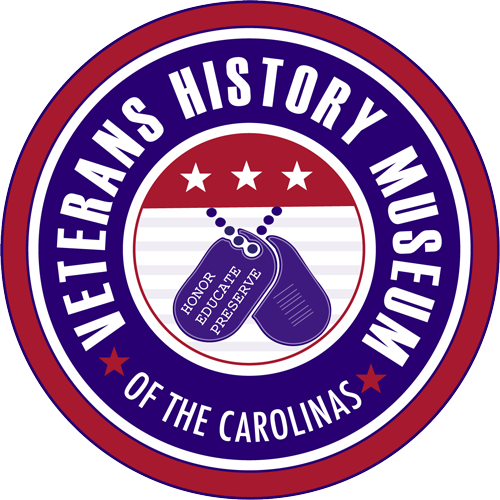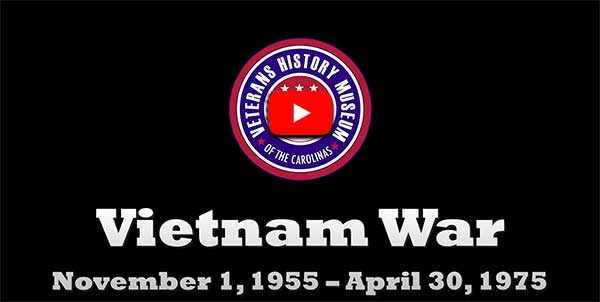Vietnam Exhibit
This realistic exhibit features an artillery observer’s forward outpost in a jungle setting complete with weapons and equipment. There are mannequins outfitted in both Vietnam period uniforms and flight suits. Featured is an exhibit of captured equipment and flags from Viet Cong and North Vietnamese soldiers. This is one of the most popular exhibits in the Museum.
This exhibit is dedicated to Vietnam veteran Mike Di Rocco,
US Army Special Forces and USMC.
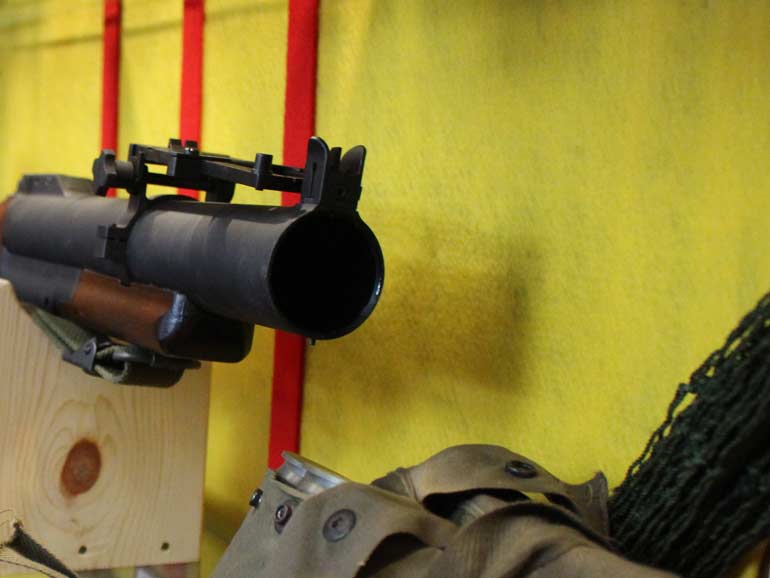
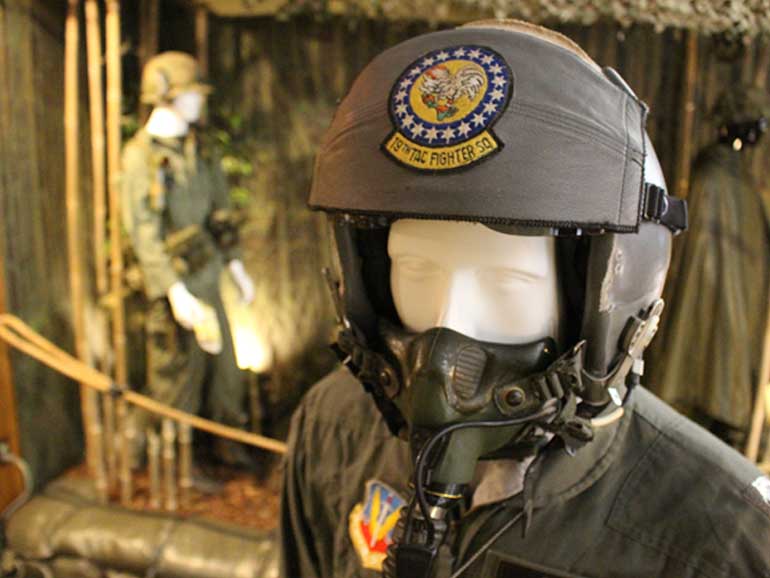
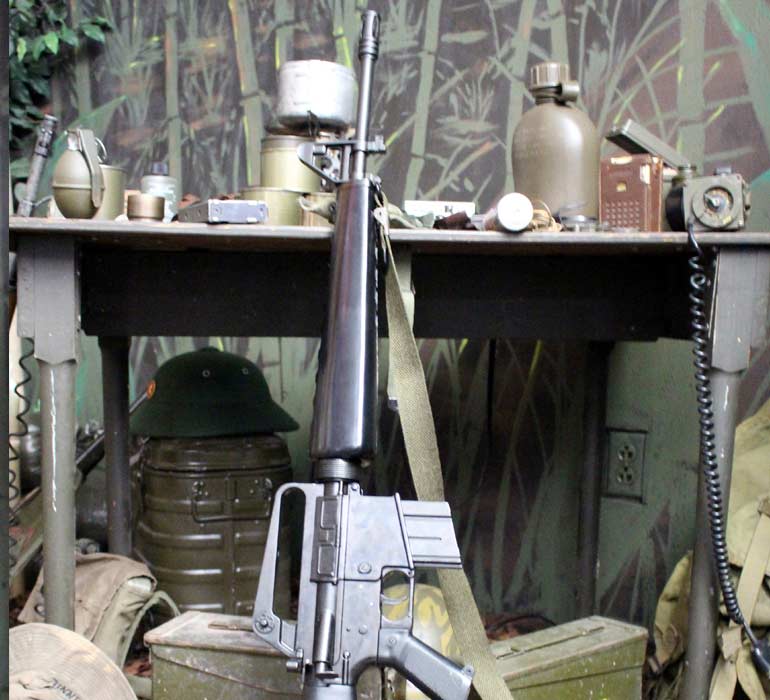
Please click on the above picture to view this video on YouTube. There is age sensitive content which requires this video to be viewed directly on YouTube.
The Vietnam War
November 1, 1955 – April 30, 1975
“They stepped forward to serve their country like generations before them.
They did not choose their war; that was done by the nation’s leaders — and circumstance.”
— Lieutenant General John M. Brown, III, US Army, Retired
American’s involvement in the Republic of Vietnam began in the 1950’s when President Eisenhower sent aid and advisors to South Vietnam. It concluded four presidents later when President Ford ordered the evacuation of personnel from the U.S. embassy in Saigon.
The struggle pitted Ho Chi Minh’s Communist government of North Vietnam and the Viet Cong Communist guerillas in South Vietnam against the government of South Vietnam and its principal ally, the United States.
The war began as a political response to Communist expansion. But as the conflict escalated, national fears and economic interests played ever-greater roles in the war, and the fate of American forces in Vietnam became a political football for both parties.
Nearly 3 million Americans served in Vietnam and the surrounding waters. By the war’s end, millions of Vietnamese were dead. More than 58,000 Americans perished in Vietnam.
This is the story of their Vietnam experience.
The Enemy
The North Vietnamese Army and the Viet Cong guerillas sought to unite Vietnam under Communism and rid the country of “Yankee Imperialists.” Battle-hardened after fighting the French for six decades, they excelled in jungle warfare.
The North Vietnamese poured troops and ammunition into the south along the Ho Chi Minh Trail — 12,000 miles of twisted roads and paths through Laos and Cambodia. Despite incessant B-52 bombings, the conduit was always re-routed with little disruption to enemy activity.
The Viet Cong were everywhere in South Vietnam. Dressed like all the other civilians, their “invisibility” enabled men, women, and children to strike Americans and melt into a crowd. Patrols were always on high alert as they entered villages where any civilian could be the enemy with a grenade.
The Viet Cong often disappeared into complex tunnel systems laced with booby traps which set off grenades or overturned boxes of scorpions and venomous snakes. American soldiers known as “tunnel rats” crawled through the claustrophobic darkness to gather information and clear the narrow tunnels. The tunnels were a maze of dips, climbs, and bends, where every turn could reveal an enemy ambush.
Elite Special Forces teams parachuted into the Central Highland villages of South Vietnam to recruit the indigenous mountain people, or Montagnards. Ferocious fighters and experts with lethal bows and arrows, they developed strong loyalty to the Green Berets and fought bravely in commando engagements against the Viet Cong.
The Terrain
U.S. forces on patrol traipsed through thick jungles, elephant grass, sharp vines, and bamboo. They waded through swamps and across flooded rice paddies enduring giant leeches and poisonous snakes. Camouflaged poisoned punji sticks, booby traps, and land mines laced the terrain, causing loss of limbs or death. American jungle boots included holes for drainage and steel soles to protect against punji sticks.
In the Mekong Delta, Viet Cong insurgents used small boats to transport weapons and supplies through the vast system of waterways. US Navy River Patrol Boats, armed with M-16s, twin 50-caliber and M-60 machine guns, and grenade launchers cruised the delta, inserting and extracting troops and providing direct fire support.
Many roads proved lethal. Land mines and snipers threatened the lives of truck drivers transporting essential supplies throughout the country.
On the sea, Navy ships served as aircraft carriers, hospitals, artillery support, and amphibious transportation, assisted by the Coast Guard and the Merchant Marine.
The Sky
Overhead, the iconic Huey helicopter served as a weapon and a means of transporting troops and supplies. To soldiers and Marines, the distinctive “whop-whop-whop” of the rotor blades signaled either imminent insertion into a hot zone or a rescue from hell. Heroes to the ground troops, Huey pilots knew the slightest delay could be the difference between life and death.
Planes and helicopters sprayed millions of gallons of toxic defoliants, especially Agent Orange, on forests that concealed the enemy and the crops that fed them. Hundreds of thousands of Vietnamese and Americans have died. Many still endure the lingering effects of their exposure.
By the mid-60’s, the US Air Force fleet included stealth jets, gunships, and bombers. To counter them, North Vietnam deployed surface-to-air missiles and anti-aircraft artillery. Most American POWs were pilots and other airmen, incarcerated in Vietnamese prisons. In the notorious Hoa Lo prison, known by Americans as the Hanoi Hilton, POW’s endured horrifying conditions and brutal treatment by their captors. In 1973, the North Vietnamese released 591 prisoners during Operation Homecoming.
Returning to “The World” (Home)
Vietnam was America’s first television war. Uncensored reporting from Vietnam provided coverage from combat zones, and, for the first time, exposed Americans to the realities and brutality of war. The nightly news announced daily body counts. Images of hundreds of caskets arriving at American airports profoundly affected Americans and fueled antiwar sentiment.
Unlike WWII veterans, whose return was embraced with gratitude and parades, many Vietnam War veterans experienced indifference, rejection, and contempt. With no debriefing, many soldiers and Marines returned to “the world” alone, an “army of one” – fighting Viet Cong one day, landing in the US just 48 hours later. In one of the saddest outcomes of the Vietnam War, some citizens blamed returning troops for the war.
In 1973, the Nixon administration signed a peace treaty with North Vietnam. Two years later, North Vietnamese tanks rolled into Saigon and the South surrendered. Vietnam was united under a Communist regime. Everything for which Americans had fought and died was lost.
_______________________________________
“They were surprised at the anger of many Americans when they returned home. For the first time, Americans blamed our soldiers for the war. Their strength in the face of these unwarranted attacks taught the nation a lesson we must never forget. In a democracy, it is permissible to hate a war, but we must respect the soldiers we send into battle.”-
After experiencing war through these videos, we feel grief, respect, admiration, and gratefulness for those who gave all, for those who came through so changed (or damaged), and for those who loved and love them. The best we can do is to listen to their stories. To try to see through their eyes and understand what they sacrificed. This is how we honor their courage and love of our country.
